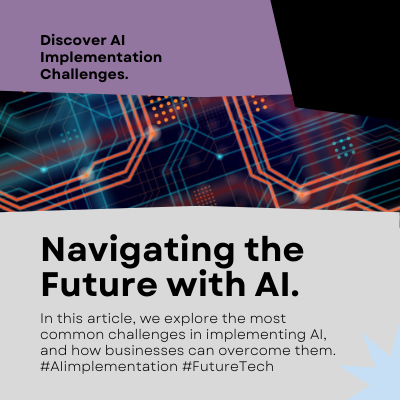While the journey to integrate Generative AI is full of potential, it’s not without its hurdles. Understanding the common challenges and learning from real-life solutions can pave a smoother path for your business. This post aims to equip you with insights and strategies to effectively overcome obstacles and maximize the benefits of AI in your operations.
Challenge 1: Understanding and Selecting the Right AI
Overview: Many SMBs struggle with the complexity of AI technologies and the plethora of choices available.
Real Solutions:
- Tips for non-technical business owners to understand AI capabilities.
- Focus on Business Solutions, Not Technical Details:
- Understand the ‘What’ and ‘Why’ Over the ‘How’: You don’t need to grasp every technical aspect of AI. Instead, focus on what AI can do for your business and why it’s beneficial. For example, if you’re considering a customer service AI tool, understand how it can improve response times and customer satisfaction, rather than the intricacies of its algorithm.
- Leverage Simplified Learning Resources
- Engage with Simplified Educational Content: There are numerous online resources, including webinars, podcasts, and articles, designed to explain AI in layman’s terms. Resources from reputable sources like AI-focused educational websites, tech industry blogs, or business technology platforms can be particularly helpful.
- Collaborate with Tech-Savvy Partners or Staff: Consider consulting with IT professionals or tech consultants who can advise on the most suitable AI solutions for your business needs. They can help you understand the capabilities and limitations of different AI tools in a business context.
- Focus on Business Solutions, Not Technical Details:
Remember, the goal isn’t to become an AI expert but to gain enough understanding to make informed decisions about implementing AI in your business strategy.
Challenge 2: Budget and Resource Constraints
Overview: SMBs often operate with limited resources and may find the cost of AI integration daunting.
Real Solutions:
- Research affordable or scalable AI tools specifically suited for SMBs. Schedule demos and consider trial periods for tools that could help you achieve your stated goals.
Challenge 3: Skill Gaps and Training Needs
Overview: The lack of in-house AI expertise can hinder the adoption and effective use of AI technologies.
Real Solutions:
- Online Courses and Tutorials: Utilize platforms like Coursera, Udemy, or LinkedIn Learning, which offer courses specifically designed for business owners and non-technical individuals to understand and apply AI. These courses often range from beginner to advanced levels, allowing you and your team to build AI knowledge at your own pace.
Challenge 4: Ensuring Data Privacy and Security
Overview: Handling sensitive data and maintaining privacy can be a significant concern when integrating AI.
Real Solutions:
- Adopt Strong Data Encryption: Implement robust encryption standards for storing and transmitting data.
- Regular Security Audits and Updates: Conduct regular security audits of your AI systems to identify and address vulnerabilities.
- Employee Training on Data Security: Regular training sessions should be conducted to make employees aware of potential security risks and best practices for data handling and privacy.
Challenge 5: Measuring ROI and Managing Expectations
Overview: SMBs need to understand the return on investment and set realistic expectations for AI outcomes.
Real Solutions:
- Define Clear, Quantifiable Goals: Before integrating AI, establish specific, measurable objectives. Whether it’s reducing operational costs, increasing sales, improving customer satisfaction, or streamlining processes, having clear targets will help you gauge the effectiveness of AI in meeting these goals.
- Implement Performance Metrics: Develop a set of key performance indicators (KPIs) relevant to the AI’s intended purpose. For example, if AI is used for customer service, metrics might include response time, resolution rate, and customer feedback ratings. Regularly track these metrics to assess the AI’s impact.
- Regular Review and Adjustment: AI integration is not a set-and-forget solution. It requires ongoing evaluation and fine-tuning. Schedule periodic reviews of AI performance against your benchmarks.
Implementing Generative AI is not without its challenges, but with the right approach and insights, these can be transformed into opportunities for growth and innovation. By learning from the experiences of those who’ve navigated these waters before, your SMB can more confidently and effectively embrace the AI revolution. Stay tuned for our next post, where we’ll explore the exciting future of Generative AI and what it means for your business.
If you’d like to learn more, please book a call with a member of our team. Click Here


